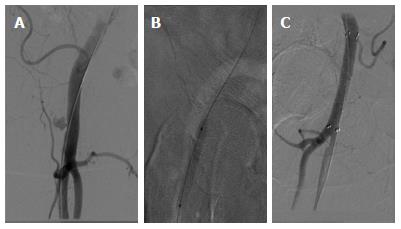Copyright
©2014 Baishideng Publishing Group Inc.
World J Cardiol. Aug 26, 2014; 6(8): 836-846
Published online Aug 26, 2014. doi: 10.4330/wjc.v6.i8.836
Published online Aug 26, 2014. doi: 10.4330/wjc.v6.i8.836
Figure 4 Post-transcatheter aortic valve implantation arterial perforation.
At the end of the transcatheter aortic valve implantation procedure, digital subtraction angiography of the right iliac-femoral artery showed a perforation of the right common femoral artery (CFA) (A); angioplasty of the right CFA was performed by the crossover approach via the contralateral iliac-femoral artery; a 7.0 mm x 40 mm peripheral balloon (Admiral Xtreme, Invatec, Roncadelle, Italy) was inflated to 10 atm at the perforation site (B); because of the persistence of hematic extravasation, a 8.0 mm x 60 mm covered stent (Fluency Stent-Graft, BARD Peripheral Vascular, AZ, United States) was implanted, followed by dilation of 7.0 mm x 40 mm and 8.0 mm x 20 mm balloons (Admiral Xtreme, Invatec, Roncadelle, Italy) to 12 atm. At final angiography, optimal sealing of the arterial breach without residual hematic extravasation was documented (C).
- Citation: Dato I, Burzotta F, Trani C, Crea F, Ussia GP. Percutaneous management of vascular access in transfemoral transcatheter aortic valve implantation. World J Cardiol 2014; 6(8): 836-846
- URL: https://www.wjgnet.com/1949-8462/full/v6/i8/836.htm
- DOI: https://dx.doi.org/10.4330/wjc.v6.i8.836









